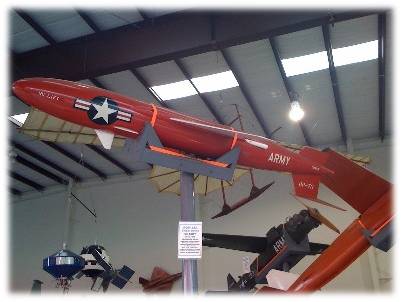
Northrop RP-76 Target Drone
The Northrop RP-76 (US Army AQM-38A) was a high-performance,
rocket powered, radio controlled, and recoverable target missile.
It was used for surface-to-air, and air-to-air missile firing
practice. It was carried to altitude by fighter aircraft and
air launched. Since mid-1959, over 2,000 of these targets were
ordered by the US armed forces. They were used to train US Army
Nike missile crews at US and Far East target ranges. They were
also used for air-to-air missile training of US Navy all-weather
interceptor fighter pilots at the Pacific Missile Range, Point
Magu, California.
The key structural component of the RP-76 was the steel engine
case housing the solid propellant rocket motor. To this, the
plastic wings, nose section, and aft fuselage were attached.
The integral flight control package, including control vanes,
was located in the nose section. Augmentation equipment included
a Luneberg lens which provided reliable passive reflectivity
at a minimum cost as a target for the Nike-Ajax, Nike Hercules,
and Hawk missiles.
During the summer of 1960, at the White Sands Missile Range in
New Mexico, an AQM-38A climbed to a height of 72,500 feet, attaining
a speed of Mach 1.03 during the flight. Later, a new high performance
version, designated RP-76E, attained a speed in excess of Mach
2 at an altitude of 80,000 feet.
RP-76 Specifications
Manufacturer Northrop Corporation, Ventura Division, Ventura,
California
Propulsion Solid-propellant rocket engine with twin thrust nozzles
canted 15 degrees outboard in the horizontal plane
Flight Controls Automatic flight control system with command
control override. The control vanes formed an integral part of
the fuselage
Recovery A three foot diameter ribbon brake parachute and a second
stage 24 foot diameter ring slot main canopy were deployed at
a predetermined altitude
Scoring There were provisions for a burst distances indicator
(BDI).
Tracking The RP-76 used a Northrop RPTA-l tracking aid system.
Smoke generating and night light kits were used for visual tracking.
Span 5 feet, 0 inches
Length 9 feet, 8 inches
Height 1 foot, 6.2 inches
Fuselage Diameter 12 inches
Empty Weight 197 pounds
Launch Weight 301 pounds
Maximum Speed Mach 1.25
Ceiling Over 72,000 feet
Endurance 23 minutes (including 14 minutes of gliding)
Acquisition Range in S-Band 110,000 yds.
Tracking Radar Range in X-Band 73,000 yds.
